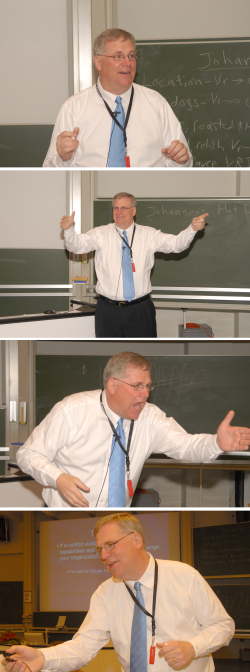Barney's Ten Commandments
According to strategy and management expert, Jay B. Barney, the common perceptions of how companies gain profitability are characterized by myths and faulty assumptions. When Barney gave a guest lecture at NHH he presented ten "truths" of strategy and management.
15.04.2008 - Torgeir Uberg Nærland. Translated by Jessica Hartenberger
In one of his "truths", Barney explained that the properties of a product have little influence when it comes to the company's competitive advantage.
"When, for example, Sony launched the Walkman sports edition, it was not long before the competition had copied the technology and in this way abolished Sony's competitive advantage. The same occurred when Sony later launched the sports edition of the Discman."
"This shows that product properties in themselves do not necessarily lead to competitive advantage. Sony's capability of technological innovation, on the other hand, is a resource which has given large advantages in competition against other companies."

BARNEY CIRCUS. There was a great deal of energy and a high tempo surrounding Barney's lecture. NHH lecturer Svein T. Johansen was used for a case in "Johansen's Hot Dogs" and Barney made up a hotdog jingle on the spot, together with one of the students (bottom).
Foto: Knut André Karlstad
Leading the Field
Jay B. Barney alongside Michael Porter, is likely to be the most influential contributor within the field of strategy today, and is a professor at Fisher College of Business at Ohio State University.
Barney is especially known as one of the main representatives in the movement within strategy and management known as "resource-based theory". This theory emphasizes the different resources found within a company as the most important factors for achieving competitive advantage in relation to other companies.
Responsibility of the Staff
Another of Barney's "truths" pointed out that competitive advantage is not just a business affair for the management of a company, but it is also the responsibility of each and every staff member.
"The custodians at Nissan-factories realize that their job is an integral part of the production process, where, for example, to maintain the cleanliness of the factory floor is completely essential in keeping production up," exemplifies Barney.
"The awareness and attitude of every single staff member in this way becomes a resource for the company, which can create a competitive advantage."
Trust
Friendship, teamwork, and trust are other resources which Barney emphasized as crucial for a company's profitability.
"If these resources are in place in a company they can generate big competitive advantage in both the short and long term. These are the resources that must develop over time, and that give huge advantages when they are first in place.
Barney's 10 Truths:
1. The attractiveness of an industry cannot be evaluated independent of the resources and capabilities a firm brings to an industry.
2. Competitive advantage is every employee's responsibility.
3. Doing just as well as the competition ensures mediocrity.
4. Product features are almost never sources of sustained competitive advantage; capabilities needed to create products can be.
5. It is usually better to be an excellent you then a mediocre them.
6. If it is harder for them and easier for you, it is likely to be a source of sustained competitive advantage.
7. Trust, friendship, and teamwork-this is the stuff of sustained competitive advantage.
8. Firms with valuable, rare, and costly to imitate capabilities can screw up their organization and still make money-don't learn from them.
9. Firms with valuable capabilities that are neither rare nor costly to imitate must rely on their organization to make them distinctive.
10. If If a conflict exists between your capabilities and your organization, change your organization.
|

